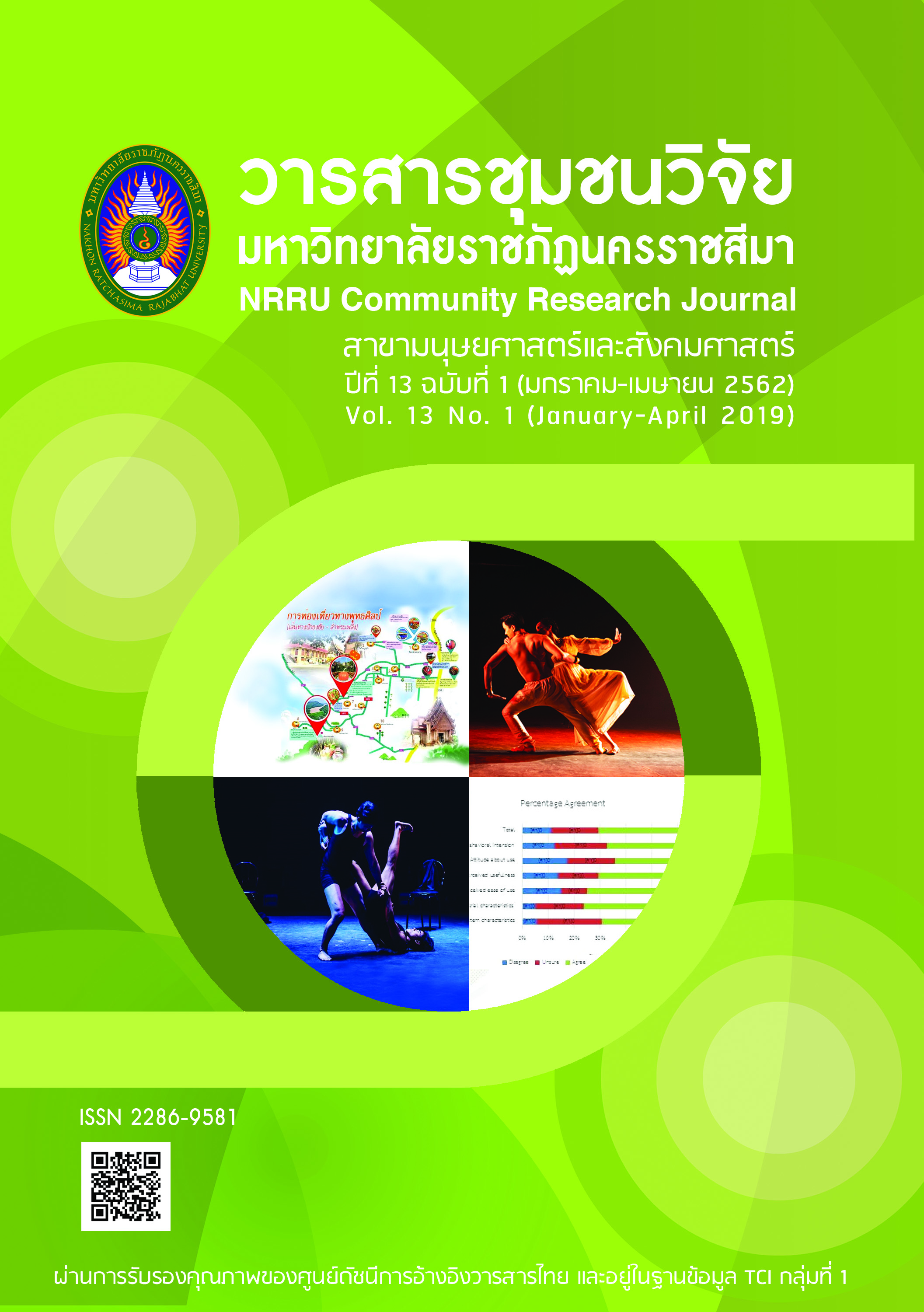THE CONSTRUCTION OF MATHEMATICAL PROBLEM-SOIVING PROCESS TEST FOR STUDENTS IN GRADE 9 IN THE OFFICE OF PROVINCIAL EDUCATION CHONBURI
DOI:
https://doi.org/10.14456/10.14456/nrru-rdi.2019.20Keywords:
Test, Mathematics, Mathematic problem solution strategyAbstract
The purpose of this research is to create the examination for quality and intersection point of the mathematic problem solution strategy for grade 9 students in first semester year 2017 in Chonburi Education service area. They were two experimental groups, one group was teachers who analyzed the examination with 6 sample random sampling mathematic teachers, the other one group was 474 students who tested G*Power 3.1 by using Multi-Stage Sampling. The tools of this research were two mathematical problem-solution strategy tests were the multiple choices test and writing test. The both of research instruments were first tested with 150 students in grade10, and the experimental research with 314 students. The Results of study revealed that:
- 1. After the experiment at IOC>0.5, the multiple choice 36 items ( =0.24-0.79, =0.47) and the next writing 9 items ( =0.60-0.64, =0.58), the students spent time average 90 minutes per tool.
- 2. The multiple choices had difficulty values as 0.25-0.79, Discrimination value as 0.21-0.77, the writing test had difficulty values as 0.50-0.63, Discrimination values as 0.32-0. Validity values as Multiple choices=0.78, writing=0.82. Reliability values as multiple choices=0.93, writing=0.74, Reliability of teacher who analyzed the 2 examinations=0.99, the correlation of multiple choice and writing test and intersection score as 0.90 at significant 0.01.
- 3. The first mathematical examination multiple choices had total score=36, intersection point=25.98 (72.17%) and the students who passed intersection of multiple choices examination=130 students and writing examination total score=90, intersection point=61.25 (68.06%) and the students who passed the writing examination=136 students.
References
พรรษา นุ่มศรี. (2554). ได้พัฒนาแบบทดสอบวัดความสามารถทางการคิดแก้ปัญหาในกลุ่มสาระการเรียนรู้คณิตศาสตร์ของนักเรียนชั้นประถมศึกษาปีที่ 6. วิทยานิพนธ์ปริญญาการศึกษามหาบัณฑิต สาขาวิชาการวัดผลการศึกษา มหาวิทยาลัยทักษิณ, สงขลา.
พิไลลักษณ์ บัวทอง. (2554) ได้สร้างแบบวัดความสามารถในการแก้ปัญหาวิชาฟิสิกส์ เรื่อง แรงและการเคลื่อนที่สำหรับนักเรียนชั้นมัธยมศึกษาปีที่ 5. วิทยานิพนธ์ปริญญาดุษฎีบัณฑิต สาขาวิจัยและประเมินผลการศึกษา มหาวิทยาลัยราชภัฎมหาสารคาม, มหาสารคาม.
ไพศาล วรคำ. (2552). การวิจัยทางการศึกษา. กาฬสินธุ์ : ประสานการพิมพ์.
________. (2554). การวิจัยทางการศึกษา (พิมพ์ครั้งที่ 2). มหาสารคาม : ตักสิลาการพิมพ์.
________. (2556). การวิจัยทางการศึกษา (พิมพ์ครั้งที่ 6). มหาสารคาม : ตักสิลาการพิมพ์.
ล้วน สายยศ และอังคณา สายยศ. (2543). เทคนิคการวัดผลการเรียนรู้ (พิมพ์ครั้งที่ 2). กรุงเทพมหานคร : สุวีริยาสาส์น.
เวชฤทธิ์ อังกนะภัทรขจร. (2555). ครบเครื่องเรื่องควรรู้สำหรับครูคณิตศาสตร์ : หลักสูตรการสอนและการวิจัย. กรุงเทพมหานคร : จรัลสนิทวงศ์การพิมพ์.
ศิริชัย กาญจนวาสี. (2552). ทฤษฎีการทดสอบแบบดั้งเดิม (พิมพ์ครั้งที่ 6). กรุงเทพมหานคร : สำนักพิมพ์แห่งจุฬาลงกรณ์มหาวิทยาลัย.
สถาบันทดสอบทางการศึกษาแห่งชาติ (องค์การมหาชน). (2556). รูปแบบข้อสอบ สาระและมาตรฐานการเรียนรู้ ข้อสอบ O-NET ป.6 ม.3 ม.6 ปีการศึกษา 2556. สืบค้นเมื่อ 8 ธันวาคม 2560, จาก www.niets.or.th
สถาบันส่งเสริมการสอนวิทยาศาสตร์และเทคโนโลยี กระทรวงศึกษาธิการ.. (2555ก). การวัดผลประเมินผลคณิตศาสตร์. กรุงเทพมหานคร : ซีเอ็ดยูเคชั่น.
สรินยา ศรีธัญ (2554). การสร้างแบบวัดทักษะกระบวนการทางวิทยาศาสตร์ขั้นบูรณาการสำหรับนักเรียนชั้นมัธยมศึกษาปีที่ 4. วิทยานิพนธ์ปริญญาดุษฎีบัณฑิต สาขาวิจัยและประเมินผลการศึกษา มหาวิทยาลัยราชภัฎมหาสารคาม, มหาสารคาม.
สำนักงานเขตพื้นที่การศึกษามัธยมศึกษาเขต 18. (2558). วิเคราะห์เปรียบเทียบผลคะแนนเฉลี่ยโอเน็ต. ชลบุรี : เอ็มไซน์โฆษณา.
________. (2560). วิเคราะห์เปรียบเทียบผลคะแนนเฉลี่ยโอเน็ต. ชลบุรี : เอ็มไซน์โฆษณา.
สุรีพร อนุศาสนนันท์. (2554). การเปรียบเทียบคุณภาพของการกำหนดมาตรฐานระหว่างวิธีแองกอฟที่ได้รับการปรับปรุงกับวิธีบุ๊คมาร์ค. วิทยานิพนธ์ปริญญาดุษฎีบัณฑิต สาขาวิชาการวัดและประเมินผลทางการศึกษา ภาควิชาวิจัยและจิตวิทยาการศึกษา คณะครุศาสตร์ จุฬาลงกรณ์มหาวิทยาลัย, กรุงเทพมหานคร.
Charles, R.; Lester, F.; & O’Daffer, P. (1987). How to Evaluate Progress in Problem Solving. Reston, Virginia : National Council of Teacher of Mathematics.
Cizek, G. J., Bunch, M. B., & Koons, H. (2007). Standard setting: A guide to establishing and evaluating performance standards on tests. Thousand Oaks, CA : Sage.
Kane, M. (1994). Validation the performance standards associated with passing score. Review of Educational Research, 64(3), 425-461.
Lovett, H. T. (1977). The Effect of Violating the Assumption of Equal Item Mean in Estimating the Livingston Coefficient. Educational and Psyghological Measurement.
National Council of Supervisors of Mathematics (NCSM). (1977). Position paper on basic skills. n.p.
National Council of Teachers of Mathematics (NCTM). (1980). An agenda for action: Recommendations for school mathematics of the 1980s. Reston, VA : Author.
Polya, G. (1957). How To Solve It : A New Aspect of Mathematical Method (2nd ed.). New York : Doubleday and Company.
Zieky, M. J., Perie, M., & Livngston, S. (2008). Cutscores: A manual for setting standards of performance on educational and occupational tests. Prinnceton, NJ : Educational Testing Service.




